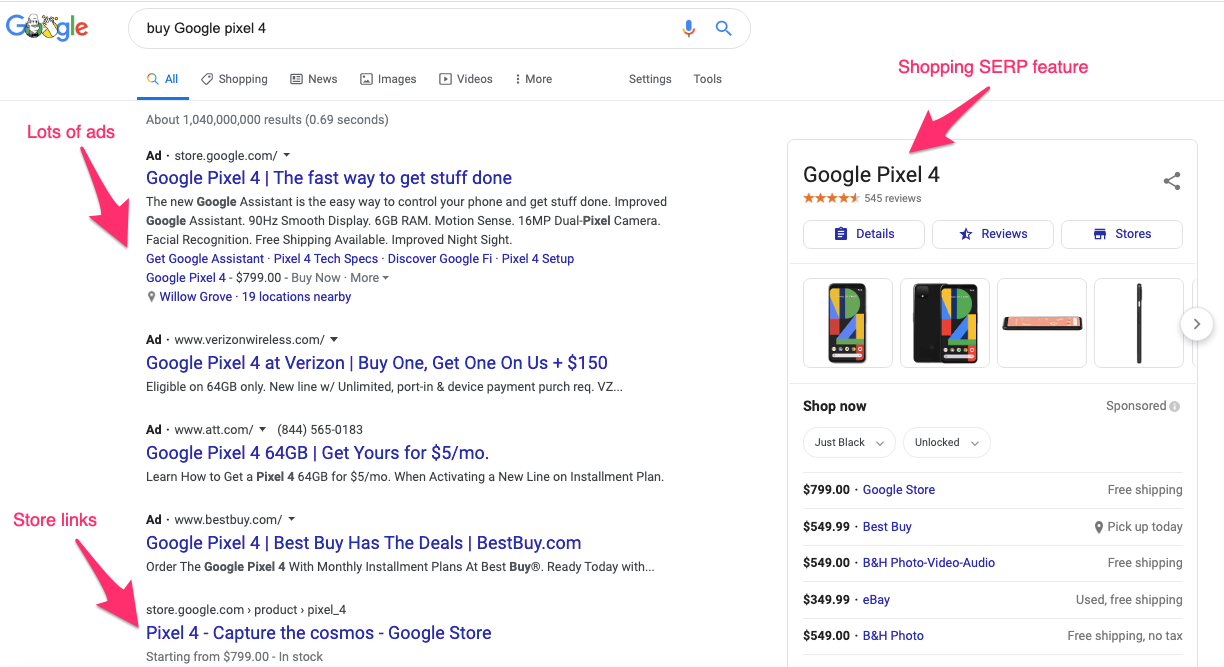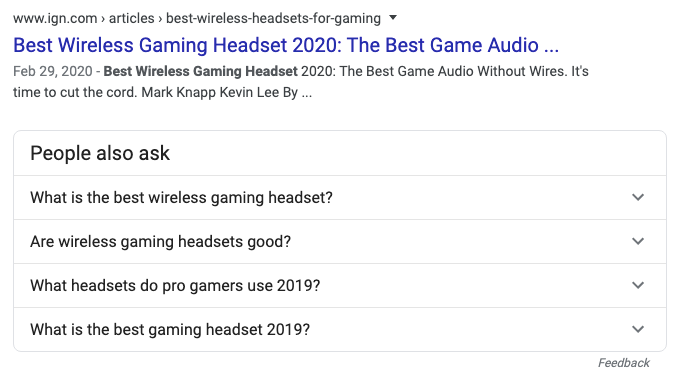Search intent can be boiled down to a single question: why? Whenever you start thinking about the type of content you’re going to create for a certain topic, “why?” is the most important question you can ask.
Not just why you’re creating the content, but why your reader needs it, why it’s valuable, and why someone is searching for it. Understanding the answers to those questions is what differentiates great content from everything else.
While often overlooked during traditional keyword research, search intent helps you understand why someone might be searching for a specific topic in their search engine of choice. It’s the best tool you have for creating relevant, engaging content. On top of monthly search volume or keyword difficulty, search intent helps you think about the type of content that’s going to best serve a particular search query.
In today’s article, we’re going to talk through all things search intent—what it is, why it matters, and how you can use it to transform your content into something that’s truly valuable for your audience. Let’s dive in!
What Is Search Intent?
Search intent is a way for you to understand the why behind any given search query. It provides valuable context about the reason (or reasons) someone typed their question into a search engine or asked their phone. Think of it as the driving force behind why people use search engines.
There are four main types of search intent: informational, transactional, navigational, and commercial. Each category helps you discern the underlying questions behind the keywords a user types into the search bar.
Four Types of Search Intent
When you know the specific type of search intent behind a given query, it helps you create content that’s tailored to the question being asked. Essentially, it helps you solve the problem a searcher has.
Informational Search Intent
This is the type of search someone does when they want to learn more about a given topic. When you’re creating content for informational searches, it’s important to think about how you’re going to help the person searching with this query to learn more about their given topic.
Examples of informational search intent include:
- Fillet whole salmon
- How to install a Brita filter
- Website CSS best practices

You’ll often see similar search features and results for informational searches. Much of the content leans toward instructional and how-to articles or videos. You’ll also find questions and knowledge panels as Google attempts to provide as much information up front about the search as possible.
Transactional Search Intent
When someone is looking to purchase a product or service, that’s a transactional search. The content you would create for a transactional search should be laser-focused on the value you can provide to a potential customer.
Examples of transactional search intent include:
- Spotify premium membership
- Buy Google pixel 4
- Crocs on Amazon

When you encounter a transactional search, you’ll likely see an increase in ads and shopping-related search features. This example showcases just how much of an increase in ad content there is from an informational search.
Navigational Search Intent
This is the type of search someone does when they need to get to a specific website. While you won’t necessarily create content targeting this type of search specifically, it’s important to understand how to format individual pages on your site to appeal to this kind of searcher.
Examples of transactional search intent include:
- Facebook login
- SpyFu blog

Navigational searches are often the most simple to identify. The SERP will likely highlight specific pages of a website that the searcher needs in order to get to where they want to go.
Commercial Search Intent
This is the type of search someone performs when they are thinking about purchasing something in the future. You should create content that is similarly value-focused on transactional search intent, but with less sales-oriented language. This is your opportunity to talk about how your product or service solves a specific problem for searchers.
Examples of commercial investigation search intent include:
- Best yoga mat for hot yoga
- Bluetooth headphones wirecutter
- Best smartphone fitness app

Commercial searches will look similar to transactional searches, with an increased number of ads and shopping-related SERP features. One main difference is that commercial searches will often show review sites in top-ranking results. This is the search engine’s attempt to highlight content that helps searchers make purchase decisions.
Why is Search Intent Important for SEO?
If the goal of a search engine is to serve relevant results to its users, you must make sure your content satisfies that user as well.
Once you understand the intent behind a search, you can better determine what type of content will best satisfy the user. Satisfying the user's intent is critical for ranking success. For example, you don't want to publish a long-form blog post when the user intends to buy a product.
When you have a solid understanding of these four main types of search intent, it’s easier to create content that’s targeted to the specific needs of the searcher performing them. But gaining that understanding isn’t always easy, because it requires intuition as well as strong research skills.
How to Determine Search Intent for Any Keyword
Determining search intent is equal parts research and intuition. Let’s go back to the core question of search intent: why? When you’re working to understand the search intent behind specific keywords or phrases, ask what is your north star.
With tools like SpyFu, you can easily build a keyword list and track top-ranking content. From there, you have to add the human element. Go to the SERP, think about why you might search for that phrase, go to the SERP, see what other companies are doing. There are a number of clues that can help you figure out what people are thinking when they type specific words into the search bar.
Start by looking at the questions section in SpyFu’s Keyword Research tool. We put together the top questions people ask that are connected to a specific keyword or phrase, in the natural language a search is likely to use:

People are not only looking for best practices but also for how to practice their CSS skills. This means that the intent behind the keyword is likely informational, since searchers are looking for practical/tactical content.
Using Google, it’s easy to intuit what they think people are searching for by looking at the various different SERP features being used. Just take this example search:

Alongside the expected sponsored ads and ranked content, we see the following search features:


Not only do we have additional questions to look at via the “People also ask” feature, but there are also sections for “Popular products” and “Videos.” Google obviously thinks someone wants to make a purchase, but is the intent transactional or commercial investigation? It can sometimes be hard to tell, but we’d say commercial investigation, and here’s why:
- There are no action words in the search signaling purchase intent (buy, purchase, cost, etc.).
- The search is in the research and discovery phase of the customer journey.
Based on the SERP features presented and on our analysis of the content on the page, it’s likely that the person searching with this phrase wants to learn more about what gaming headset to buy rather than move forward with their purchase.
There’s definitely a learning curve here; the more you think about search intent and investigate specific search queries, the better you’ll be at determining which type of intent is correct. And once you’ve figured that out, it’s time to move on to thinking about how to use that knowledge to create better content of your own.
Understanding Search Intent Helps You Write Better Content
By now, you can see how useful search intent is for understanding why people search for specific keywords and phrases. That’s what makes it such a valuable tool for content creation. Search intent shows your readers that you actually understand their needs and are prepared to provide a solution to their problem. Whether you’re performing new keyword research, or digging through existing data to source article ideas, knowing the intent behind any given search helps you create content that’s of real value for the reader.
The driving factor behind this value is that, when you accurately parse the search intent of a given query, it’s easy to create an article that is relevant to a real-world need. Because relevancy is a significant ranking factor for search engines, you’ll be able to rank better by figuring out search intent.
Let’s say you’re a SaaS platform that provides customers with the ability to create shared documentation for remote teams. One of the long-tail keywords on your list is going to be something along the lines of how to organize my documentation. The search intent behind that phrase is pretty straightforward: people searching for it want to learn how to do something, and that’s textbook informational intent.
So, what kind of article should you create? The easy answer is probably How to Organize Your Company Documentation. But you’d be missing out on other opportunities that are inherent in that keyword. There are a number of additional articles you could create that would help people truly understand document management at their company. Here are a few:
- X Organizational Methods to Streamline Your Company Wiki
- Increase Engagement with Your Documentation with These X Steps
- The X Best Tools for Organizing Your Company Documentation
- How a Disorganized Company Wiki Hurts Team Production
Each of these articles fulfills another important aspect of creating a culture of documentation at your company. Search intent isn’t a singular thing; each of those examples helps the reader understand why organizing their documentation is important, and each provides real answers.
And understanding search intent will also show you whether or not your effort to create certain types of content is warranted. If the intent behind a specific search doesn’t match for the problems your product or service solves, then you might need to go back to the drawing board and find a new keyword.
Let’s use the keyword website HTML as an example. The intent behind a keyword like this is kind of tricky because people searching for it could be interested in a number of different things. They could be looking for HTML best practices, tips and tricks, or educational resources, or they may just want to understand what HTML is a bit better. The type of article you’d create for each of those intents would be significantly different.
If your goal is to write an article that provides a series of advanced tips and tricks for optimizing the HTML on your website, you’d want to make sure that’s what people actually need when they search for that term. Drop that into SpyFu’s Keyword Research tool and it looks like most of the Similar Keywords and Questions skew toward a beginner resource.
That’s your first sign that the article you are planning to create probably doesn’t match the intent of the keyword you are targeting. To validate that assumption, let’s take a look at what the results look like on Google:

We’re seeing more beginner resources here as well. Your article providing advanced strategies for HTML optimization probably wouldn’t rank well for this keyword. Using that information, you have two options:
- Go back to your keyword research report and find a different target keyword--probably a long tail one that signals specific needs.
- Come up with a beginner’s resource for building a website with HTML.
Either way, understanding the intent of the keyword ensures that the effort you put into creating your article won’t be wasted on content that would have a difficult time ranking in the SERP.
Taking a look at the results for this keyword can also help you determine the type of content you need to create as well. If we click through the top-ranking content, all of it tends to be tactical. When you start writing your own article, it would be a good idea to mirror this style in order to increase your chances of competing with w3schools.com (the site that currently owns the first page of Google).
This is why search intent is so valuable for marketers. It’s your key to understanding what kind of content a searcher is looking for when they type anything into the search bar. It gives you insight into their motivations and their needs. That makes it easy to create content that’s not only valuable but also has an increased chance at ranking well for any given search.
Always Ask Why
When you think about why a person is searching for a specific question, it helps you create content that’s tailored to their specific needs. That not only provides more value to your readers but also ensures that you’re always putting effort into content that’s as relevant as possible.
It’s that relevancy and value that boosts rankings in the SERP. When you miss the mark, you’re not just decreasing your ability to rank— you’re also showing potential customers or users that you don’t really understand their needs. That’s why search intent is so important; it reminds you to ask why.

